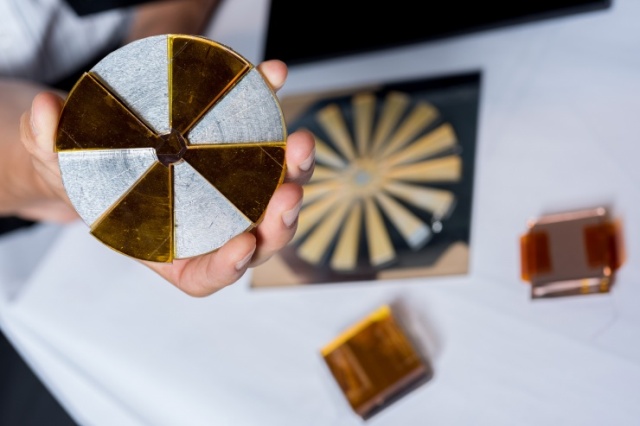The standards aim to quantify the performance of triboelectric nanogenerators (TENGs). Over 60 variations of TENGs are currently being developed and the standards will allow researchers to compare and select the most appropriate device for specific applications.
 More than 60 research groups worldwide are now developing variations of the triboelectric nanogenerator (TENG). Shown in this image is a collection of the devices. (Credit: Rob Felt, Georgia Tech)
More than 60 research groups worldwide are now developing variations of the triboelectric nanogenerator (TENG). Shown in this image is a collection of the devices. (Credit: Rob Felt, Georgia Tech)
The standards, proposed by the Georgia Institute of Technology analyze the structural performance of four main types of TENG devices are illustrated in the September 25th issue of Nature Communications journal.
Triboelectric nanogenerators are a new energy technology that has shown phenomenal potential. Here, we have proposed standards by which the performance of these devices can be quantified and compared. These standards will be useful for academic researchers developing the devices and for future industrial applications of the nanogenerators.
- Prof. Zhong Lin Wang, Georgia Institute of Technology
The triboelectric effect relies on electrostatic induction, the phenomenon that some materials become electrically charged when they touch a moving contact possessing a surface made from another material. Triboelectric nanogenerators employ the triboelectric effect to produce small ammounts of electrical power from mechanical motion, such as sliding, vibration, or rotation.
Electricity created using TENG technology show potential as a supplement or substitute for batteries. The technology has evolved to the position where it is now used for powering small gadgets and wearable consumer devices, thereby paving the way for widespread sensing and infrastructure systems.
Because of the large number of devices being developed, people need to have a standard for judging the performance of these nanogenerators.
- Prof. Zhong Lin Wang, Georgia Institute of Technology
The researchers had observed that using standards in the fields of thermoelectronic and photovoltaic devices enabled their advancement. However, the performance of TENG devices is quite complicated to quantify due to the use of a variety of materials and designs.
Wang and his team recommend a general figure of merit in the paper to compute the potential energy produced by the TENG devices. The general figure of merit comprises data from two sources. Firstly the surface charge density yielded by the specific materials used for device construction, and secondly the capacity of the specific TENG structure used. The output is evaluated against the input of mechanical energy to compare the efficiency of different devices.
Measurements are based on plots of voltage build-up and the total transfer of electrical energy from each device. The structural figures of merit are found using theoretical calculations for all of the four main nanogenerator modes alongside experimental results generated by the TENG devices. Values for charge density can be determined using liquid metal to collect the surface charge.
By varying the structure of a TENG and the source of mechanical energy lots of applications are possible. The key four groups are lateral sliding mode, vertical contact-separation mode, freestanding triboelectric-layer mode, and single-electron mode. Additionally, hybrid combinations of these modes are possible.
For instance, the vertical contact-separation mode is powered by the periodic contact and separation of two dissimilar materials with coated electrodes on their top and bottom surfaces. Whereas in the lateral sliding mode, two surfaces temporarily slide together, then separate to create a charge.
We can calculate for the four modes what are the best sizes and shapes, and the best power output you can expect for a specific structural figure of merit.
- Prof. Zhong Lin Wang, Georgia Institute of Technology
Cellulose, polyethylene, fluorinated ethylene propylene, polarized polyvinylidene fluoride, natural rubber, and Kapton were some of the materials used for the analysis.
Wang’s research team members, postdoctoral fellow Yunlong Zi and graduate student Simiao Niu, developed the measurement and theoretical methods. They took into consideration the factors considered for setting up the standards for heat engines and other technologies.
For triboelectric generators, because the mechanical input is varied, you have different kinds of measurements to evaluate the performance,” said Zi. “These figures of merit are considerably more complicated than would be needed for characterizing solar cell performance, for example
- Yunlong Zi, Georgia Institute of Technology
The research team’s proposed standards only form the initial step in an extended process of becoming accepted. Going forward, Wang will be involved in explaning the standards to other research teams working on TENG devices. He believes nearly 60 research teams could be involved in the development of TENG devices, and this number is likely to expand with more advancement in nanogenerators.
As wearable electronics become more popular and fashionable, we will need a better way to power them. Triboelectric nanogenerators can play a large role in that. We have spent a lot of time improving the power efficiency, and the field is quickly expanding
- Prof. Zhong Lin Wang, Georgia Institute of Technology
Wang adds that the proposed standards could also be altered to suit piezoelectric generators and other systems meant for generating electrical energy from mechanical motion.